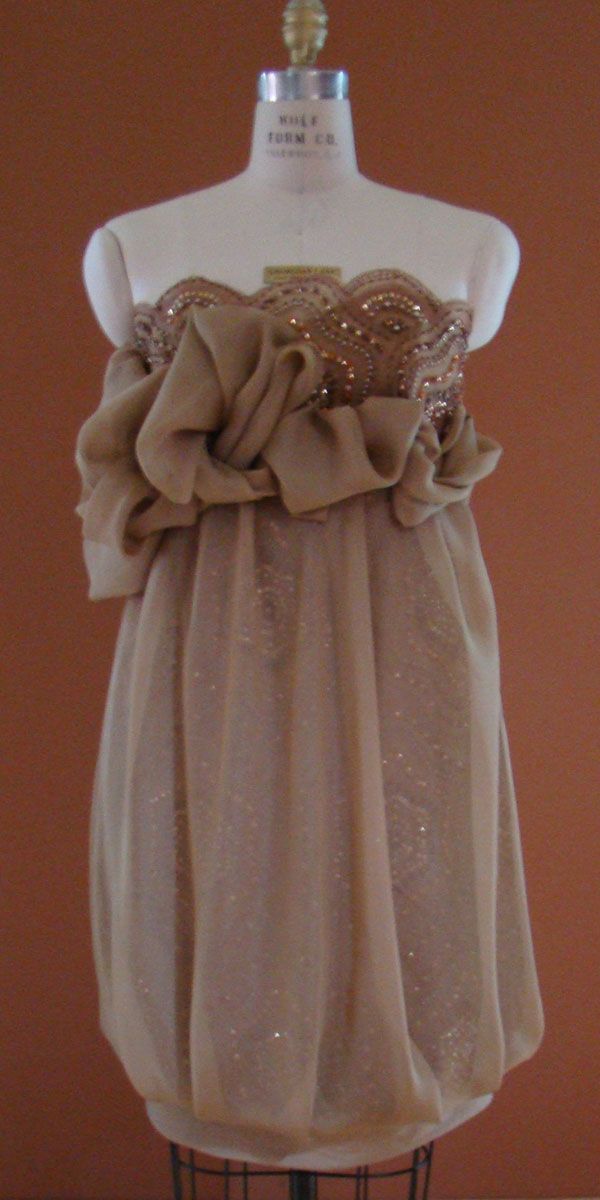
Ann Vidovic's chiffon and beaded tulle dress from the Association of Sewing and Design Professionals 2008 Challenge
Recently the Association of Sewing and Design Professionals and Threads magazine had their annual garment competition, and this year the theme was fluid fabrics.
After showcasing the winners in Threads magazine issue #142 and a few of the finalists online here, we challenged you to see what you could come up with using these challenging fabrics for a chance to win a $150 gift certificate from Fashionista Fabrics.
To get into the fluid fabrics spirit, I’ve compiled a few tips and tricks to help you when dealing with chiffon fabrics:
- Needles – Sizes 60/8 or 65/9. Try Sharp (HM, HJ) needles and always start the project with a new needle in your machine.
- Thread – Choose a lightweight cotton thread in a color to match.
- Cutting – Lay tissue paper out on your cutting surface and lay the chiffon out over the paper. Arrange your pattern pieces over the fabric and cut out your pieces through the paper. This will help the fabric from shifting around all over your cutting surface. Only cut through one layer of chiffon at a time.
- Interfacings – Try a flesh-toned organza or a self fabric.
- Presser foot – Load your machine with a single-hole throat plate and a straight-stitch presser foot. This will help keep the fabric from sinking into the wider hole in a zigzag throat plate.
- Pins – Use super-fine pins to prevent holes and snags.
- Seams – Try narrow French seams. These will conceal the raw edges and keep the chiffon’s drape.
- Stitching – Use a 2.0 mm stitch length and hold the top and bobbin threads when you begin sewing. Never backstitch and hand knot the threads to secure them in place instead.
Do you have any chiffon tips to share, too?



































If you're working with synthetic fabrics you can use a hot tool (for woodworking) to cut the fabric. Use the the sharp point that looks like an icepick. Then your fabric wont fray. Takes some practice and it doesn't work well on some kinds but it's wonderful when it does work.
Great tip, April! Thanks so much for sharing this.
I spray my fluid fabric with a fabric stabilizer. It makes my fabric firm enough, easy to handle and not float around when sewing or serging. Check the products to make sure it won't gum up your machine and make sure your it will be fine on the fabric you use. I've used it on polyester chiffon and silk chiffon with no problems as I can hand wash both afterwards.
Hi
I've recently sewed silk/cotton chiffon which is beatiful to work with, and very rewarding, but needed a lot of handsewn seams. On the bias seam though I used a 2x1 zigzag and that gave it the elasticity needed for a perfect seam.
Fiona
I recently tried to make a chiffon dress using tissue paper as a stabililzer during sewing. I tore the tissue paper away after making the seams. This method DOES give you perfectly smooth, flat seams, but it is very messy and very time consuming. I was making a dress that had miles and miles of seams (don't ask). It was just such a miserable experience that after a while, I couldn't face it. I finally threw away the fabric and pattern to free myself to work on other projects.
April what do you cut on when you do that? awesome idea!
I use my wood burning tool on tempered glass to cut and seal synthetic fabrics like April. A glass cutting board is another option.
I noticed on Project Runway one of the designers placed the fabric over the pattern to cut. With plain spray starch and a erasable marker for tracing the piece, it will be easier to get accurate seams for sewing. Of course, I would cut inside the line so the marker won't show...
I use white kraft paper to draft my patterns. It's about the same weight as grid lined pattern paper. I like that it's heavier than tissue. I was also sewing layers together to create a tone on tone on either side the bust of the dress. I sewed right through the paper and it kept the fabric straight as a dream. Works great when the pattern pieces are small.
My friend's daughter has a bridal gown that is overlayed with chiffon. I know how to hem the inside fabric but how to do the chiffon??
I am making a bias cut dress w/silk charmuse as the lining and silk chiffon as the dress. Since the chiffon is so stretchy, will I be able to sew the neck and sleeve openings together and sew the side seams separately so they hang independently and have some flow and movement? I have had trouble in the past with the side seams not stretching and the rest of the dress stretching more.